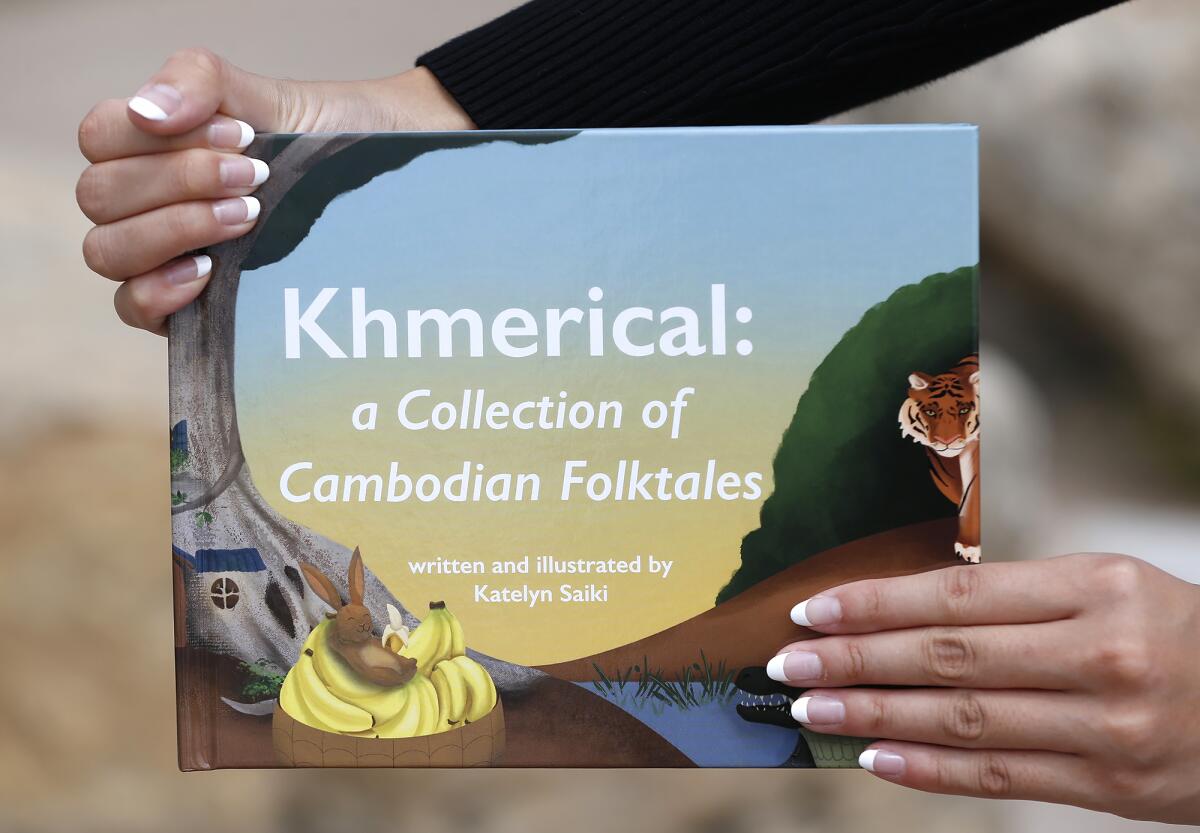Corona del Mar Girl Scout wins scholarship for nonprofit, book highlighting Cambodian art and culture

- Share via
Katelyn Saiki grew up hearing stories about Cambodia from her grandparents.
The lessons she learned have paid off: Saiki recently found out she won a $10,000 scholarship after attaining the Girl Scout’s highest achievement, the Gold Award, thanks not only to her book on Cambodian folklore but the establishment of her nonprofit, Cambodian Revival of Arts, Folklore, and Traditions.
The Khmer Rouge was the communist regime that led to the genocide of the Cambodian peoples under the direction of the Communist Party of Kampuchea general secretary Pol Pot. The genocide led to the death of nearly a quarter of the country’s population in the late 1970s. It is estimated nearly 2 million people lost their lives in the atrocity.
“My grandfather ... is the sole survivor of his family of the [Khmer Rouge] genocide, and from him, I learned that nearly a quarter of the population died and as a result that a lot of art and history was lost to the communist regime,” Saiki said.
Many professionals, including doctors, lawyers, teachers, engineers and scientists, were killed along with their extended families. Saiki’s grandparents and her mother were among the thousands of refugees that fled the country in the 1980s.
“A lot of [Cambodia’s] identity was being destroyed, and that’s what inspired me for my Gold Award [work] because I wanted to center my project around something that is deeply connected to me.”

According to a report published by the United Nations Educational, Scientific and Cultural Organization (UNESCO) office in Phnom Penh and Cambodia’s Ministry of Culture and Fine Arts in 2002 on the rehabilitation of the country’s performing arts, the genocide’s impact on Cambodian performance culture “plunged this most sophisticated of cultures to almost total annihilation.
“During the tyrannical regime of Pol Pot, innumerable performers were banished from Phnom Penh to try to survive in a countryside they barely understood,” the report continued. “Most of them didn’t return, dying either of illness or starvation, or often murder as a direct result of their skills and links, as the Khmer Rouge saw it, to a decadent class and royalty.”
Saiki said part of the inspiration for her project came from a 2018 trip she took to Cambodia with her family, visiting the village that her grandparents and mother were from.
“I was immersing myself in the community, saw the schools and hospitals that my grandparents helped with to give back, but when I visited the schools, I saw they weren’t really appreciating their own heritage. No art was really offered compared to other subjects amidst Cambodia’s reconstruction,” Saiki said. “So, when I returned to America, I wanted to help preserve this folklore. I’m from a family of artists and storytellers, and I was always taught to take pride in my Cambodian culture.”
For her book, “Khmerical: A Collection of Cambodian Folktales,” which she wrote and illustrated, Saiki recounted three Cambodian folktales that her grandfather dictated and verified with teachers in the country to ensure its accuracy. It was her hope, she said, that she would be able to spread more Cambodian culture though it, but she encountered roadblocks in terms of credibility with libraries.
That’s where the nonprofit came in, she said. Once that was formed, it helped her create a platform for herself and lend credibility to the book. She said she was then able to partner with several libraries and elementary schools, including the Mark Twain Neighborhood Library and the Michelle Obama Neighborhood Library in Long Beach.
Long Beach is home to the largest Cambodian population outside of Cambodia.

“I feel that Cambodian voices are very underrepresented in the media. When you think of Asian culture, Cambodians aren’t the first to come to mind. We aren’t really a part of the multicultural conversation, but I want to expose people to our culture,” Saiki said. “People still need to know about Cambodia’s history and heritage, and most people know the dark and sad parts of our history, but I wanted to shed light on the beautiful parts too. It’s my way of saying that after the [Khmer Rouge] genocide that we’re still here. We still know who we are, and we take pride in our identity.”
She said she found out that she was a finalist in early June for the Gold Award, and that it was official that she was the winner by late June. Saiki is heading to USC this fall to study business administration and narrative studies, both fields of study that she feels working on her award project guided her toward.
““Girl Scouts of Orange County is incredibly proud of Katelyn. The mission of Girl Scouts is to build girls of courage, confidence, and character, who make the world a better place, and Katelyn exemplifies that. Her Gold Award project has impact and sustainability. It stretches 8,000 miles to Cambodia,” Vikki Shepp, Girl Scouts of Orange County’s chief executive officer, said in a statement. “It builds community, and shows Girl Scouts have the power to change the world.”
Saiki is one of 110 who are part of the 2023 Gold Award Girl Scouts class in the county.
All the latest on Orange County from Orange County.
Get our free TimesOC newsletter.
You may occasionally receive promotional content from the Daily Pilot.




